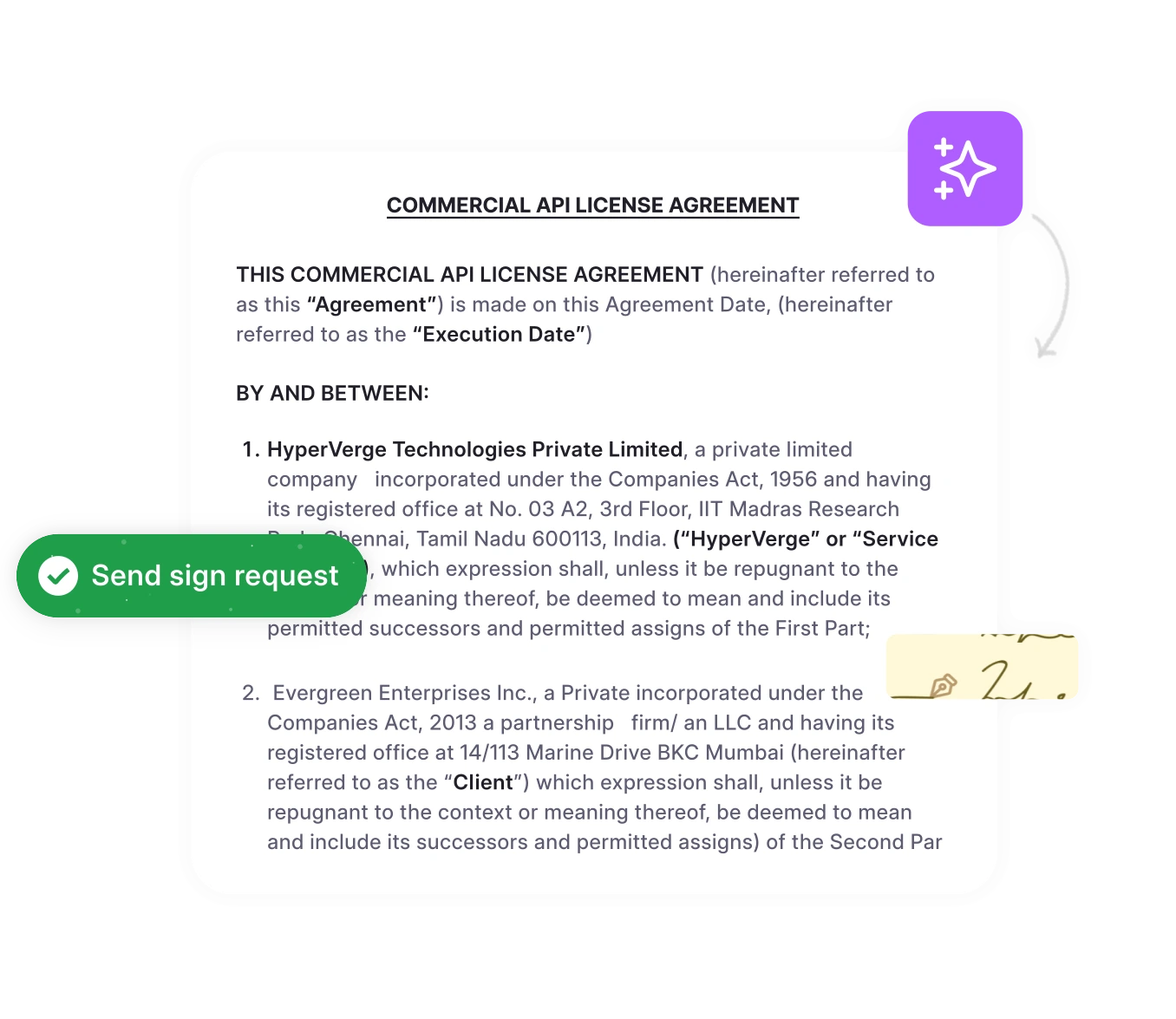When a freelance designer walks away claiming ownership of your company logo, or an ex-employee launches a competing product using your proprietary technology, the root cause is often the same: a missing or poorly written intellectual property agreement. These disputes cost businesses thousands in legal fees and can derail partnerships, product launches, and revenue streams.
This guide covers everything you need to know about intellectual property agreements, including the different types, essential components, when you need one, and how to protect your creations. Whether you’re hiring contractors, licensing technology, or entering joint ventures, understanding contract clauses that govern IP ownership is critical for protecting your business interests.
Before we dive deeper, here’s a free resource to help you get started right away.
Read Template
(View-only — no download required.)
What is an intellectual property agreement?
An intellectual property agreement is a legal contract that defines who owns creations like inventions, designs, written content, software code, or brand identities, and establishes the terms under which others can use these assets. Such contracts establish ownership rights, usage permissions, compensation terms, and protections for both parties involved in IP transactions.
The terms “intellectual property agreement” (often abbreviated as IP agreement) and “intellectual property contract” are often used interchangeably, though “agreement” typically implies mutual consent while “contract” emphasizes the legally binding nature. Both refer to the same type of business contract (IP contract) that protects valuable intangible assets.
When a software company licenses its technology to an enterprise client, the intellectual property licensing agreement specifies what the client can do with the software, any restrictions on use, payment terms, and how long the license lasts. Without this agreement, disputes over usage rights and revenue sharing become inevitable.
Tired of tracking agreements in spreadsheets?
Modern contract management platforms centralize all IP agreements with automated alerts and searchable clause libraries.
Book a DemoWhat are the types of intellectual property?[4 types explained]
Before diving into IP agreements, it’s important to understand what types of intellectual property these contracts protect. Intellectual property falls into four main categories, each with different legal protections and business applications.
| IP Type | What It Protects | Protection Duration | Business Example |
| Patents | Inventions, processes, methods | 20 years from filing | Mobile app algorithm, manufacturing process |
| Copyrights | Creative works, written content | Life of author + 70 years | Website copy, marketing materials, software code |
| Trademarks | Brand names, logos, symbols | Renewable indefinitely | Company logo, product name, tagline |
| Trade Secrets | Confidential business information | Indefinite (while secret) | Customer lists, recipes, pricing strategies |
Patents
Patents protect new inventions and innovative processes that provide a competitive advantage. A tech startup that develops a unique machine learning algorithm would file for patent protection, then use an intellectual property license agreement to allow other companies to use the technology for a fee.
Copyrights
Copyrights protect original creative works, including written content, graphics, videos, and software code. When you hire a writer to create blog posts, a copyright contract ensures your company owns the finished work rather than the freelancer retaining rights.
Trademarks
Trademarks protect brand identifiers that distinguish your products or services from competitors. Companies use intellectual property licensing agreements to allow franchisees or partners to use their trademarked brand names and logos while maintaining quality standards.
Trade secrets
Trade secrets encompass any confidential business information that confers a competitive advantage. Unlike patents, trade secrets remain protected indefinitely as long as they stay confidential. Companies use non-disclosure agreements to protect intellectual property when sharing sensitive information with potential partners or investors.
What are the different types of intellectual property agreements?
Different business situations require different types of intellectual property agreements (IP agreements). Understanding which type fits your needs prevents costly mistakes and ensures proper legal protection for all parties involved.
| Agreement Type | Primary Purpose | IP Ownership After Agreement | Common Business Scenario |
| Assignment | Transfer all ownership rights | Transfers to buyer | Startup selling patent to corporation |
| Licensing | Grant limited usage rights | Remains with original owner | Software company licensing to clients |
| Employment | Company owns employee creations | Belongs to employer | Developer building product at tech firm |
| NDA | Protect confidential information | No ownership transfer | Investor pitch, partnership discussions |
| Co-ownership | Share ownership between parties | Split among multiple parties | Two companies co-developing product |
1. Assignment agreements
An intellectual property assignment agreement permanently transfers all ownership rights from one party (the assignor) to another (the assignee). Once signed, the original creator has no remaining rights to the IP unless they are explicitly reserved in the contract.
Assignments of intellectual property rights are common when companies acquire startups primarily for their technology or patents. The purchasing company wants complete ownership to commercialize the innovation without restrictions. These intellectual property transfer agreements typically include upfront payment rather than ongoing royalties since ownership fully changes hands.
The agreement should clearly identify which specific IP assets transfer, any excluded rights, and warranties that the assignor actually owns what they’re selling. Contract clauses governing representations and warranties protect buyers from purchasing IP with hidden ownership disputes or prior claims.
2. Licensing agreements
A licensing agreement for intellectual property allows someone to use IP while the original owner retains ownership. The licensee pays fees or royalties for defined usage rights within specific parameters like geographic regions, industries, or time periods.
Intellectual property license agreements (also spelled intellectual property licence agreement in UK English) come in two main forms: exclusive licenses grant rights to only one licensee, while non-exclusive licenses allow multiple parties to use the same IP simultaneously. An enterprise license agreement might allow a corporation to deploy licensed software across all departments while restricting use by competitors in the same industry.
Royalty agreements for intellectual property typically structure payments as a percentage of revenue generated from the licensed IP, fixed periodic fees, or a combination of upfront payment plus ongoing royalties. These licensing terms directly impact profitability for both parties.
3. Employment intellectual property agreements
An employee’s intellectual property agreement establishes that any IP created by employees during their employment belongs to the company, not the individual. Without these agreements, employees could claim ownership of innovations they develop on company time using company resources.
Employee intellectual property assignment agreements typically cover all work product related to the company’s business, inventions made using company equipment or information, and sometimes discoveries made outside work hours if related to company projects. HR contracts that include IP clauses are essential for technology companies, creative agencies, and any business where employees generate valuable intellectual property.
Companies should include exceptions for prior inventions the employee brings to the job and clarify that personal projects unrelated to company business remain the employee’s property. Clear boundaries prevent disputes when employees leave and start their own ventures.
4. Non-disclosure agreements
While not strictly an ownership transfer, a non-disclosure agreement for intellectual property (also referred to as an intellectual property non-disclosure agreement) protects confidential information from unauthorized disclosure. Companies use non-disclosure agreements for intellectual property before sharing trade secrets, proprietary processes, or innovative concepts with potential partners, investors, or vendors.
Read also: Supplier Agreement: Key Terms, Best Practices & Expert Insight
A non-disclosure agreement for intellectual property typically defines what information is confidential, who can access it, permitted uses, and how long confidentiality obligations last. These confidentiality contracts prevent recipients from using your trade secrets to compete against you or sharing them with third parties.
NDAs differ from other IP agreements because they don’t transfer ownership or grant usage rights. They simply create a legal obligation to keep information secret. However, they’re often the first step before negotiating licensing or assignment agreements.
5. Co-ownership agreements
An intellectual property partnership agreement or intellectual property ownership agreement establishes shared ownership when multiple parties contribute to creating IP. These arrangements are standard in joint ventures, research collaborations, or when companies co-develop new products or technologies.
Intellectual property ownership agreements for co-created assets must address several critical issues: what percentage each party owns, how decisions about commercialization get made, how revenue from the IP gets distributed, and what happens if one party wants to sell their stake. Without clear terms in a partnership agreement template, co-owners often clash over exploitation rights and profit sharing.
These agreements should also specify whether each party can license their ownership share independently or if unanimous consent is required for all licensing deals. Clear governance prevents deadlock when business interests diverge.
Key components of an intellectual property agreement
Regardless of type, effective IP agreements share common elements that establish clear terms and prevent future disputes. Missing any of these contract clauses creates gaps.
| Component | What It Defines | Why It Matters |
| Parties | Legal names of all individuals or entities | Establishes who is legally bound |
| IP Description | Specific assets covered by agreement | Prevents scope disputes |
| Ownership & Rights | Who owns IP and what rights are granted | Core legal protection for both parties |
| Compensation | Payment terms, royalties, revenue sharing | Financial clarity and expectations |
| Confidentiality | What information stays protected | Safeguards trade secrets and sensitive data |
| Indemnification | Who covers losses from IP disputes | Risk allocation and legal defense |
| Term & Termination | Duration and exit conditions | Defines relationship boundaries |
| Dispute Resolution | How conflicts get resolved | Avoids costly litigation |
1. Ownership and rights provisions
The intellectual property rights agreement (also called an IP ownership agreement) must explicitly state who owns the IP. Vague language like “jointly developed” or “co-created” leads to disputes when one party wants to license or sell the asset.For licensing deals, the agreement should detail exactly what rights are transferred. Can the licensee modify the IP? Sublicense it to others? Use it in derivative works? Intellectual property clauses in service agreements should specify permitted uses with concrete examples and clear exclusions.
Courts require specific identification with particularity to determine what, if anything, is deserving of trade secret protection. The lack of a tailored analysis as to what specific information actually constitutes a trade secret undermines analysis of whether reasonable measures were taken to protect alleged trade secrets. Rather than advancing a hazy grouping of information, companies must define their intellectual property assets with precision in their agreements.
Read
2. Financial terms and compensation structure
Whether structured as upfront payments, ongoing royalties, or revenue sharing, intellectual property sale agreements must precisely define compensation. Elements of a contract require consideration, meaning both parties must receive something of value.
Royalty agreements for intellectual property typically calculate payments as a percentage of net revenue, gross sales, or per-unit sold. The agreement should specify payment frequency, accounting procedures, audit rights to verify sales figures, and late payment penalties.
For intellectual property purchase agreements involving full assignment, buyers often structure payments as an initial sum plus milestone-based payments tied to commercialization success or revenue targets.
3. Confidentiality and protection obligations
Even when IP ownership is transferred or licensed, protecting confidential information through an intellectual property confidentiality agreement remains critical. Intellectual property confidentiality agreement terms should define what information is confidential, exceptions for publicly available information, permitted disclosures, and the duration of confidentiality obligations.
These provisions are especially important in technology licensing where source code, algorithms, or technical specifications are shared. The agreement should require the receiving party to implement reasonable security measures to prevent unauthorized access or disclosure.
4. Duration, termination, and transition
IP agreements should specify how long the arrangement lasts and under what conditions either party can terminate. Perpetual intellectual property license agreements continue indefinitely unless terminated for cause, while fixed-term agreements expire after a set period unless renewed.
Contract termination provisions should address what happens to the IP upon termination. In licensing deals, can the licensee continue using IP developed during the license period? Must they destroy all copies? Clear transition terms prevent post-termination disputes.
Intellectual property transfer agreements should include representations and warranties that the transferor actually owns the IP, has the right to transfer it, and that the IP doesn’t infringe on third-party rights.
When do you need an intellectual property agreement?
Certain business situations demand IP agreements to prevent ownership disputes and protect valuable assets. Failing to implement proper contracts in these scenarios often results in expensive litigation and lost revenue.
1. When hiring contractors or freelancers
According to the Association of Corporate Counsel, ownership and assignment of intellectual property should be explicitly addressed in independent contractor agreements because, unlike with employees, ownership may lie with the freelancer or contractor rather than the hiring company. Without proper assignment language, companies risk losing ownership of critical work product, including copyrights, patents, and trade secrets.
What the agreement should include:
Assignment of all work product created during the engagement, definition of what constitutes deliverables covered by the agreement, and timeline for when ownership transfers (typically upon payment). The contract should use clear language like “all right, title, and interest” to ensure complete transfer.
For example, when a company hires a graphic designer to create a logo, the intellectual property assignment agreement template should specify that the company owns not just the final logo but also all preliminary sketches, source files, and derivative versions.
2. When employees create IP at work
An employee intellectual property assignment agreement clarifies that innovations, inventions, code, or creative works developed as part of employment belong to the company. This is particularly crucial in technology, pharmaceutical, and creative industries.
What the agreement should include:
Scope of covered work product (typically anything related to the company’s business or created using company resources), disclosure requirements for inventions, exceptions for prior work the employee brings to the job, and time period covered (during employment and often for a period after).
For instance, when a pharmaceutical company hires a research scientist, the intellectual property agreement for employees must state that any drug formulations, processes, or discoveries made during employment become company property. Without this clause, the scientist could claim co-ownership and demand royalties on any commercialized products.
3. When licensing your IP to third parties
Companies that license technology, content, or brand assets to third parties need comprehensive licensing terms to maintain control and generate revenue. Unstructured licensing arrangements lead to unauthorized uses, quality control issues, and revenue leakage.
What the agreement should include:
Scope of license (exclusive or non-exclusive, geographic limitations, field of use restrictions), quality control provisions for trademark licenses, sublicensing permissions or restrictions, payment terms and royalty calculations, and termination rights if the licensee breaches terms.
When a software company creates a sample licensing agreement for intellectual property, it might grant clients rights to use the software for internal operations while prohibiting resale, reverse engineering, or use by competitors.
4. When entering partnerships or joint ventures
Joint venture agreements that involve co-creating IP require clear ownership and exploitation terms from the outset. Without proper intellectual property ownership agreement templates, partners inevitably clash over commercialization rights and revenue distribution.
What the agreement should include:
Ownership percentages for jointly created IP, decision-making authority for licensing or selling the IP, revenue-sharing formulas, rights if one party wants to exit, and what happens to IP if the partnership dissolves.
Managing agreements across vendors?
Contract lifecycle management platforms automate tracking, renewals, and compliance for all your intellectual property agreements in one place.
Book a DemoWhy is an intellectual property agreement important?
Beyond legal compliance, IP agreements deliver tangible business value by protecting assets, preventing disputes, and enabling monetization strategies. Companies that implement robust IP contracts outperform competitors in innovation and revenue generation.
1. Establishes legal ownership and prevents theft
Intellectual property rights agreements create legally enforceable proof of ownership. When disputes arise over who invented something or who owns creative work, the agreement serves as evidence in court or arbitration.
Without documented ownership through intellectual property contracts, companies struggle to enforce their rights against infringers or competitors. Patent trolls and copycats specifically target businesses with weak IP documentation because they’re unlikely to defend their rights in litigation successfully.
2. Prevents costly disputes and litigation
Clear contractual terms eliminate ambiguity about rights, obligations, and compensation. When all parties understand exactly what they can and cannot do with IP, contract disputes become far less likely.
According to the American Intellectual Property Law Association’s Report of the Economic Survey, the average cost per side to litigate a copyright case through trial is $1.4 million for disputes with amounts between $10 million and $25 million. Spending resources upfront to create comprehensive IP agreements prevents these massive downstream costs.
Intellectual property protection agreements that include dispute resolution clauses can require mediation or arbitration before litigation, significantly reducing resolution costs and timelines.
3. Enables monetization and revenue generation
Licensing agreements allow companies to generate revenue from IP without manufacturing products or providing services themselves. Technology companies, content creators, and brand owners build entire business models on IP licensing revenue.
For example, a pharmaceutical company might license its patented drug formulation to generic manufacturers after patent expiration, generating royalty revenue with minimal additional investment. An intellectual property licensing agreement template structures these deals to maximize return while maintaining quality control.
IP agreements also facilitate IP sales when companies exit markets or need capital. A clear intellectual property purchase agreement with well-documented ownership makes assets more valuable and easier to sell.
4. Provides legal defense and risk management
Indemnification clauses in IP agreements allocate risk between parties. When licensing IP to third parties, the licensor typically indemnifies the licensee against breach of contract claims by third parties alleging infringement.
These provisions protect businesses from unexpected legal costs when IP disputes arise. If a competitor sues claiming your licensed technology infringes their patents, the indemnification clause requires the licensor to defend the lawsuit and cover any damages.
As IP licensing becomes more complex, businesses are placing greater emphasis on compliance, monitoring and enforcement. The risk of infringement or disputes has led to a focus on ensuring that licensing terms are clearly defined, and royalty structures are transparent and fair. Many licensors are evaluating their existing agreements as well as revising standard agreements to pivot with legal and political changes, with a heightened focus on financial and legal risk as licensing agreements come up for renewal.
Read
Manage intellectual property agreements with HyperStart
Whether you’re managing copyright assignments from contractors, licensing deals with enterprise clients, or employee IP agreements across departments, clear documentation and systematic tracking prevent disputes and protect valuable assets. Well-structured IP agreements establish ownership, define usage rights, and create enforceable terms that stand up in court.
HyperStart, a contract management platform, helps businesses create, track, and manage intellectual property agreements at scale. Centralize all IP contracts in one searchable repository, set automated alerts for license renewals and payment deadlines, use pre-approved clause libraries for consistent IP terms, and track obligations across multiple agreements. Visit HyperStart to see how contract management automation simplifies IP portfolio management.











